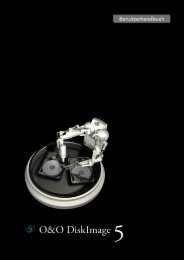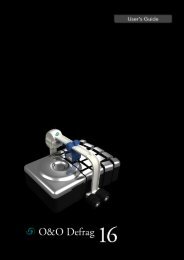Installation and System Requirements - O&O Software
Installation and System Requirements - O&O Software
Installation and System Requirements - O&O Software
You also want an ePaper? Increase the reach of your titles
YUMPU automatically turns print PDFs into web optimized ePapers that Google loves.
Supported File <strong>System</strong>s<br />
O&O Defrag supports all Windows file systems although certain conditions must be respected<br />
in order for O&O to work without any problem. The following paragraphs will tell<br />
you more about each of these file systems.<br />
FAT<br />
FAT is the oldest data system, the roots of which go back to MS DOS. It is supported by<br />
Windows. O&O Defrag can be used without any problem on FAT drives.<br />
FAT32<br />
FAT32 is the native file system of Windows 95b/98/Me. It offers certain advantages when<br />
compared to the old FAT,. Windows Vista/XP/2003 <strong>and</strong> Windows 2000 offer an integrated<br />
support of FAT32, which allows O&O Defrag to function perfectly. FAT32 drives are<br />
Windows supported by default <strong>and</strong> can be defragmented without any problem using<br />
O&O Defrag.<br />
NTFS<br />
The NTFS file system is the continuation of FAT for Windows. It provides security restrictions<br />
for accessing data <strong>and</strong> offers a higher level of security regarding file errors, <strong>and</strong> faster data<br />
access.<br />
It is native supported <strong>and</strong> O&O Defrag is able to achieve the best defragmentation results<br />
on NTFS drives.<br />
EFS<br />
Windows 2000 introduced a new file system based on NTFS <strong>and</strong> with a higher level of data<br />
security against unauthorized access <strong>and</strong> abuse. The Encrypted File <strong>System</strong> (EFS) leaves<br />
files unreadable for non-authorized users. O&O Defrag supports EFS hard drives <strong>and</strong> does<br />
not change or disturb the data integrity <strong>and</strong> security of these files.<br />
Free Space Needed for Defragmentation<br />
The following limitations are valid for O&O Defrag <strong>and</strong> are caused by Windows. They cannot<br />
be bypassed without endangering the integrity of your files.<br />
Size of the allocation units<br />
The size of the allocation units on NTFS drives on Windows 2000 has to be equal to or smaller<br />
than 4096 Bytes. NTFS drives with larger clusters cannot be defragmented. The size of<br />
the allocation unit cannot be changed after Windows has been formatted. You will, however,<br />
find third party tools which give you this possibility.<br />
Note:<br />
These limitations were removed with Windows Vista/XP <strong>and</strong> Windows 2003 so that all<br />
drives, regardless of the size of their allocation unit, can be defragmented.<br />
46 l Technical Information<br />
User's Guide for O&O Defrag 11
















